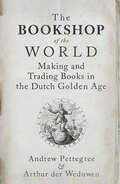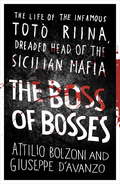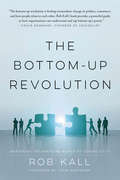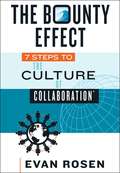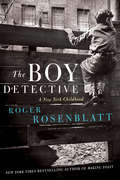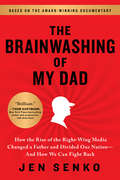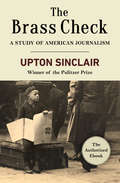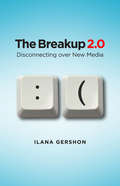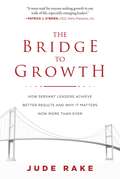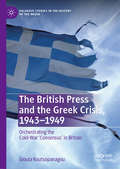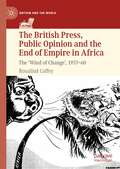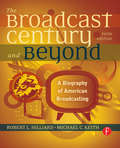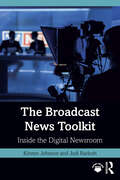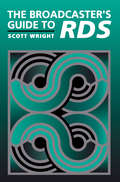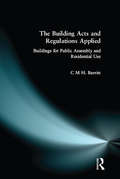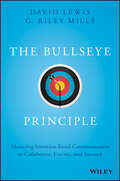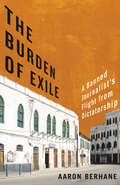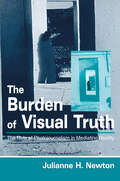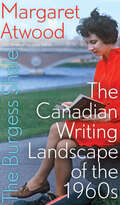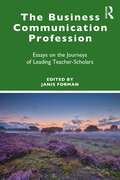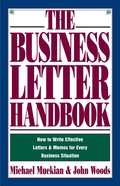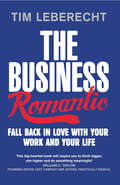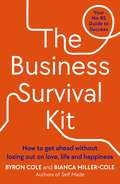- Table View
- List View
The Bookshop of the World: Making and Trading Books in the Dutch Golden Age
by Andrew Pettegree Arthur der WeduwenThe untold story of how the Dutch conquered the European book market and became the world’s greatest bibliophiles.The Dutch Golden Age has long been seen as the age of Rembrandt and Vermeer, whose paintings captured the public imagination and came to represent the marvel that was the Dutch Republic. Yet there is another, largely overlooked marvel in the Dutch world of the seventeenth century: books.In this fascinating account, Andrew Pettegree and Arthur der Weduwen show how the Dutch produced many more books than pictures and bought and owned more books per capita than any other part of Europe. Key innovations in marketing, book auctions, and newspaper advertising brought stability to a market where elsewhere publishers faced bankruptcy, and created a population uniquely well-informed and politically engaged. This book tells for the first time the remarkable story of the Dutch conquest of the European book world and shows the true extent to which these pious, prosperous, quarrelsome, and generous people were shaped by what they read.“Book history at its best.” —Robert Darnton, New York Review of Books“Compelling and impressive.” —THES (Book of the Week)“An instant classic on Dutch book history.” —BMGN - Low Countries Historical Review
The Boss of Bosses: The Life of the Infamous Toto Riina Dreaded Head of the Sicilian Mafia
by Giuseppe D'Avanzo Attilio BolzoniThis is the true story of Totò Riina, the Cosa Nostra boss who rose from nothing to become the most powerful man in Sicily. The picture emerges of a bloodthirsty, power-hungry monster who, despite his lowly beginnings, is able to outmanoeuvre the other Mafia chiefs and take control of the organisation. However, the story is not just that of Riina, but also of Sicily itself. D'Avanzo and Bolzoni have transformed a complex series of events spanning several decades into a gripping narrative.In prison for 18 years now, Totò Riina still remains the dictator of the Cosa Nostra. This book tells the haunting and disturbing tale, with thorough investigation and testimony of the Sicilian Corleone.
The Bottom-up Revolution: Mastering the Emerging World of Connectivity
by Rob KallBarack Obama, Bernie Sanders, Hillary Clinton, George W. Bush, Sir Richard Branson, Steve Jobs, and Mark Zuckerberg have all said that that change or growth happen from the bottom up.But what does it mean and how do you do “bottom up” better and smarter? Bottom up is a way of life and a way of doing business. Bottom-Up: The Connection Revolution, picks up where Malcolm Gladwell’s Tipping Point left off. It is a how-to book for businesses, leaders, organizations, activists, and individuals, cracking wide-open humankind’s biggest trend in seven million years. By understanding the roots and implications of “bottom up” and “top down” you’ll be better able to tap the incredible power of this trend, as the billionaire founders of Google, Facebook, Craigslist and Twitter have done.
The Bounty Effect: 7 Steps To The Culture Of Collaboration
by Evan RosenThe Bounty Effect: 7 Steps to The Culture of Collaboration® is a much-anticipated sequel to Evan Rosen's The Culture of Collaboration®, Gold Medal Winner in the Axiom Business Book Awards. The Bounty Effect happens when exigent circumstances compel businesses, governments and organizations to change from command-and-control to collaborative. Triggers include disruptive market forces, new competitors, regional slowdowns, natural disasters, terrorist attacks and global downturns. Seize the opportunity The Bounty Effect provides. Learn how to change any organization so that every worker is a knowledge worker and each team member produces results collaboratively. See why organizations have been traveling down a well-worn road, because the new highway has yet to be built until now.
The Boy Detective: A New York Childhood
by Roger RosenblattThe Washington Post hailed Roger Rosenblatt's Making Toast as "a textbook on what constitutes perfect writing," and People lauded Kayak Morning as "intimate, expansive and profoundly moving." Classic tales of love and grief, the New York Times bestselling memoirs are also original literary works that carve out new territory at the intersection of poetry and prose. Now comes The Boy Detective, a story of the author's childhood in New York City, suffused with the same mixture of acute observation and bracing humor, lyricism and wit.Resisting the deadening silence of his family home in the elegant yet stiflingly safe neighborhood of Gramercy Park, nine-year-old Roger imagines himself a private eye in pursuit of criminals. With the dreamlike mystery of the city before him, he sets off alone, out into the streets of Manhattan, thrilling to a life of unsolved cases.Six decades later, Rosenblatt finds himself again patrolling the territory of his youth: The writing class he teaches has just wrapped up, releasing him into the winter night and the very neighborhood in which he grew up. A grown man now, he investigates his own life and the life of the city as he walks, exploring the New York of the 1950s; the lives of the writers who walked these streets before him, such as Poe and Melville; the great detectives of fiction and the essence of detective work; and the monuments of his childhood, such as the New York Public Library, once the site of an immense reservoir that nourished the city with water before it nourished it with books, and the Empire State Building, which, in Rosenblatt's imagination, vibrates sympathetically with the oversize loneliness of King Kong: "If you must fall, fall from me."As he walks, he is returned to himself, the boy detective on the case. Just as Rosenblatt invented a world for himself as a child, he creates one on this night--the writer a detective still, the chief suspect in the case of his own life, a case that discloses the shared mysteries of all our lives. A masterly evocation of the city and a meditation on memory as an act of faith, The Boy Detective treads the line between a novel and a poem, displaying a world at once dangerous and beautiful.
The Brainwashing of My Dad: How the Rise of the Right-Wing Media Changed a Father and Divided Our Nation—And How We Can Fight Back
by Jen SenkoAfter her beloved dad got addicted to right-wing talk radio and Fox News, Jen Senko feared he would never be the same again…Frank Senko had always known how to have a good time. Despite growing up in a poverty-stricken family during the Depression and having to fight his way to middle-class status as an adult, he tended to look on the bright side. But after a job change forced Frank to begin a long car commute every day, his daughter Jen noticed changes in his personality and beliefs. Long hours on the road listening to talk radio commentators like Rush Limbaugh sucked her father into a suspicion-laden worldview dominated by conspiracy theories, fake news, and rants about the "coastal elite" and "libtards" trying to destroy America.Over the course of a few years, Jen's dad went from a nonpolitical, open-minded Democrat to a radical, angry, and intolerant right-wing devotee who became a stranger to those closest to him. As politics began to take precedence over everything else in her father's life, Jen was mystified. What happened to her dad? Was there anything she could do to help? And, most importantly, would he ever be his lovable self again? Jen began the search for answers, and found them... as well stories from countless other families like her own.Based on the award-winning documentary, The Brainwashing of My Dad uncovers the alarming right-wing strategy to wield the media as a weapon against our very democracy. Jen's story shows us how Fox News and other ultra-conservative media outlets are reshaping the way millions of Americans view the world, and encourages us to fight back.
The Brass Check: A Study of American Journalism (American Journalists Ser.)
by Upton SinclairA muckraking exposé of corruption in American journalism from the Pulitzer Prize-winning author of The Jungle Upton Sinclair dedicated his life to documenting the destructive force of unbridled capitalism. In this influential study, he takes on the effect of money and power on mass media, arguing that the newspapers, magazines, and wire services of the Progressive era formed "a class institution serving the rich and spurning the poor." In the early twentieth century, a "brass check" was a token purchased by brothel patrons. By drawing a comparison between journalists and prostitutes, Sinclair highlights the total control publishers such as William Randolph Hearst exerted over their empires. Reporters and editors were paid to service the financial and political interests of their bosses, even if that meant misrepresenting the facts or outright lying. Sinclair documents specific cases, including the Ludlow Massacre of 1914 and the Red Scare whipped up by Hearst's New York Journal and other newspapers, in which major news outlets ignored the truth in favor of tabloid sensationalism. Sinclair considered The Brass Check to be his most important and most dangerous book. Nearly a century later, his impassioned call for reform is timelier than ever. This ebook has been authorized by the estate of Upton Sinclair.
The Breakup 2.0: Disconnecting over New Media
by Ilana GershonA few generations ago, college students showed their romantic commitments by exchanging special objects: rings, pins, varsity letter jackets. Pins and rings were handy, telling everyone in local communities that you were spoken for, and when you broke up, the absence of a ring let everyone know you were available again. Is being Facebook official really more complicated, or are status updates just a new version of these old tokens? Many people are now fascinated by how new media has affected the intricacies of relationships and their dissolution. People often talk about Facebook and Twitter as platforms that have led to a seismic shift in transparency and (over)sharing. What are the new rules for breaking up? These rules are argued over and mocked in venues from the New York Times to lamebook. com, but well-thought-out and informed considerations of the topic are rare. Ilana Gershon was intrigued by the degree to which her students used new media to communicate important romantic information-such as "it's over. " She decided to get to the bottom of the matter by interviewing seventy-two people about how they use Skype, texting, voice mail, instant messaging, Facebook, and cream stationery to end relationships. She opens up the world of romance as it is conducted in a digital milieu, offering insights into the ways in which different media influence behavior, beliefs, and social mores. Above all, this full-fledged ethnography of Facebook and other new tools is about technology and communication, but it also tells the reader a great deal about what college students expect from each other when breaking up-and from their friends who are the spectators or witnesses to the ebb and flow of their relationships. The Breakup 2. 0 is accessible and riveting.
The Bridge to Growth: How Servant Leaders Achieve Better Results and Why It Matters Now More Than Ever
by Jude RakeA recent study revealed that only 21 percent of workers feel engaged and truly committed to their company’s success and goals. They don’t know how their work connects to their company’s goals or understand how they can help achieve them. Leaders have failed to fully engage workers in the development and execution of their company’s mission and goals, and ultimately its journey toward success. Too often, employees are over-managed and under-led. Jude Rake, a business leader with more than 35 years of experience leading high-performance teams, shows how servant leaders—those who serve employees by giving them what they need to fully engage and commit to achieving the company’s goals—use nine proven principles to succeed:Grow leaders and difference makers, not just followers.Build and orchestrate high-performance teams more powerful than the sum of their parts. Focus the organization on strategic priorities, simplify operations, and accelerate progress.Champion the people who purchase and use your products and services.Cultivate a performance-based culture of innovation.Communicate relentlessly.See the world through the eyes of others. Be the model you want emulated. Coach people to achieve more than they thought possible.The Bridge to Growth details how to use these principles to elevate workforce engagement, collaboration, innovation, and accountability to build a bridge from strategy to exceptional execution and results.
The Bridgend Suicides
by Ann LuceThis in depth analysis looks at how suicide was represented in the British press when 20 young people between the ages of 15 and 29 took their own lives in the South Wales Borough of Bridgend in 2008. The chapters highlight specific categories of description that journalists use to explain suicide to their readers. The study also examines the discourses that emerged around suicide that continue to perpetuate stigma and shame when suicide occurs today. Using her own experience of having lost a loved one to suicide, coupled with original research, the author gives a very frank explanation of why suicide is not accepted in society today.
The British Press and the Greek Crisis, 1943–1949: Orchestrating the Cold-War ‘Consensus’ in Britain (Palgrave Studies in the History of the Media)
by Gioula KoutsopanagouThis book provides the first detailed analysis of how interactions between government policy and Fleet Street affected the political coverage of the Greek civil war, one of the first major confrontations of the Cold War. During this period the exponential growth of media influence was an immensely potent weapon of psychological warfare. Throughout the 1940s the press maintained its position as the most powerful medium and its influence remained unchallenged. The documentary record shows that a British media consensus was more fabricated than spontaneous, and the tools of media persuasion and manipulation were extremely important in building acceptance for British foreign policy. Gioula Koutsopanagou examines how this media consensus was influenced and molded by the British government and how Foreign Office channels were key to molding public attitudes to British foreign policy. These channels included system of briefings given by the News Department to the diplomatic correspondents, and the contacts between embassies and the British foreign correspondents.
The British Press, Public Opinion and the End of Empire in Africa: The 'Wind of Change', 1957-60 (Britain and the World)
by Rosalind CoffeyThis book provides fresh insights into how the British press affected both British perceptions of decolonisation in Africa and British policy towards it during the ‘wind of change’ period. It also reveals, for the first time, the extent to which British newspaper coverage was of relevance to African and white settler readerships. British newspapers informed the political strategies and civic cultures of African activists,nationalists, liberal whites in Africa, the staunchest of white settler communities, and the first governments of independent African states and their opponents. The British press, British public opinion and British journalists became etched into the lived experiences of the end of empire affecting Anglo-African and Anglo-settler relations to this day. Arguing that the press cast a transnational web of influence over the decolonisation process in Africa, the author explores the relationships between the British, African and settler public and political spheres, and highlights the mediating power of the British press during the late 1950s. The book draws from a range of British newspapers, official government documents, newspaper archives, interviews, memoirs, autobiographies and articles printed in African and white settler papers. It will be of interest to historians of decolonisation, Africa, the media and the British Empire.
The Broadcast Century and Beyond: A Biography of American Broadcasting
by Michael C Keith Robert L HilliardThe Broadcast Century and Beyond is a popular history of the most influential and innovative industry of the century. The story of broadcasting is told in a direct and informal style, blending personal insight and authoritative scholarship to fully capture the many facets of this dynamic industry. The book vividly depicts the events, people, programs, and companies that made television and radio dominant forms of communication. The latest edition includes coverage of all the technologies that have emerged over the past decade and discusses the profound impact they have had on the broadcasting industry in political, social, and economic spheres. "Broadcasting" as a whole has been completely revolutionized with the advent of YouTube, podcasting, iphones, etc, and the authors show how this closing of world-wide broadcasting channels affects the industry.
The Broadcast News Toolkit: Inside the Digital Newsroom
by Kirsten Johnson Jodi RadoshThe Broadcast News Toolkit focuses on the writing, shooting, and production of broadcast news across multimedia platforms in a non-technical and visually engaging way. Covering a range of different story forms in broadcast news (RDR, FS, VO, VO/SOT, PKG, and Liveshots), this book illustrates basic audio/video shooting and editing techniques through straightforward examples, including online video tutorials that can be accessed via a QR code within the book. Specific issues relating to online content, social media, and audience engagement are discussed in detail, and the authors further explore why trust in news media is declining, the impact that fake news and deep fake videos have on media credibility in newsrooms, and what can be done to increase the perceived credibility of the news. Students will also learn how to write leads and teases that will keep viewers engaged. This is an ideal text for undergraduate and graduate students of Broadcast and Multimedia Journalism who are looking for a clear and concise guide to the modern digital newsroom.
The Broadcaster's Guide to RBDS
by Scott WrightThis handbook is intended to give the broadcast industry an authoritative guide to the Radio Data System (RDS), also called Radio Broadcast Data System (RBDS). Since the standard's adoption, about 700 stations have begun broadcasting RDS in the United States. There is a wide variety of encoding equipment with prices starting as low as $400, and over 30 models of RDS receivers have been introduced for cars, home receivers, portable and even PC receivers. Automobile manufacturer's such as General Motors, Ford, Audi, and Porsch now offer RDS on new vehicles. Yet despite all the support equipment in place, the FM broadcaster has been reluctant to implement and utilize this service, mainly because of a lack of understanding of what RDS can do for the station. This book finally provides the information required to understand RDS and its possibilities on a variety of levels, so that everyone involved in radio can make the most of it. Station owner, program director, salesperson, and talent alike will find the information he or she requires to maximize the possibilities of this new technology. Each feature of the system is explained in terms of its practical implementation at the station, and interviews with broadcasters currently using the system add a hands-on perspective. Scott Wright is a recognized pioneer in RDS development. As the designer of Delco Electronics' first RDS receiver, he has been extremely active in the development of the RDS standard in the US and in efforts to educate the broadcast community about its potential. He has represented Delco at the European Broadcasting Union's (EBU) RDS Forum and is currently the Chairman of the National Radio Systems Committee RBDS Subcommittee, the US standard-setting body. He is also a member of the Electronics Industries Association's (EIA) RDS Forum.
The Building Acts and Regulations Applied: Buildings for Public Assembly and Residential Use
by C.M.H. BarrittThis book forms part of a unique, highly practical and time-saving three volume presentation of the Building Regulations, each book covering all the regulations relating to specific building usage. The chapters of each volume form self-contained units covering all the Regulation requirements applicable to a particular part of a building; thus the reader can ensure that all the Regulations are fully met. Also included is a digest of published standards, guides and technical information as well as reviews of the new Eurocodes currently being introduced.The Building Acts and Regulations Applied: Buildings for Public Assembly and Residential Use covers all the regulations relating to buildings used for public assembly or residential purposes (other than houses and flats), such as theatres, sports stadia, hotels, prisons and halls of residence. It is a useful course companion for BTEC HNC/D and degree courses in building, architecture, surveying, estate management and other built environment disciplines. It is also an ideal reference source for all professionals working in these areas.
The Bullseye Principle: Mastering Intention-Based Communication to Collaborate, Execute, and Succeed
by David Lewis G. Riley MillsCritical communication lessons for sustained corporate success The Bullseye Principle is the definitive how-to guide for communicating, collaborating, and executing as a leader in the corporate arena. With these “soft skills” trending above technical knowledge in executive wish lists, this book provides invaluable guidance for new and experienced leaders alike; from the planning stages to the outcome and beyond, the discussion features critical insight and actionable tips based on award-winning methods. Polish your presence, utilize intention, influence emotion, engage workers, build relationships, make connections, and leverage the power of storytelling—it all comes down to technique. This book shows you everything you need to know to start communicating more effectively, starting today. The success of any communication rests more on how the information is conveyed than what that information actually is; at every level, in every sphere, effective leaders strive to master key skills that inspire, empower, motivate, and more. This book gives you a solid blueprint for effective communication in nearly any situation, merging the practical and theoretical to help you: Master the most challenging business interactions Become more influential as a leader and communicator Adopt a 3-step methodology to collaborate more effectively Build your personal brand and executive presence toward sustained success Most people believe that their communications skills are satisfactory for their jobs—most managers would disagree. That gap in perception presents a problem that ripples beyond your chances of promotion—where your communication fails, it has the capacity to affect the organization as a whole. The Bullseye Principle helps you build a robust repertoire of communication skills that put you ahead of the pack.
The Burden of Exile: A Banned Journalist's Flight from Dictatorship
by Aaron BerhaneIn the strict dictatorship of Eritrea, a young reporter co-founds the first independent newspaper, publishes stories that anger the president, and then has to escape to save his life and his loved ones.An idealistic journalist with a young family starts the first independent newspaper in the notorious police state of Eritrea — one of the most brutal dictatorships in the world. When the paper is shut down, he flees arrest and begins a dangerous journey to freedom, first across a desert, at night, into Sudan, pursued by Eritrean secret police, then into secret safe houses in Kenya. With the help of the United Nations, he finds sanctuary in Canada — a place he knows nothing about. Meanwhile, his wife and young children are stuck back home, in constant danger of reprisal. Berhane’s story is one of bravery amid complicated international geopolitics, of spies, guns, and betrayal, and — ultimately — of triumph and the piecing together of family in a cold new country.
The Burden of Visual Truth: The Role of Photojournalism in Mediating Reality (Routledge Communication Series)
by Julianne NewtonAs the visual component of contemporary media has overtaken the verbal, visual reportage has established a unique and extremely significant role in 21st-century culture. Julianne Newton has prepared this comprehensive analysis of the development of the role of visual reportage as a critical player in the evolution of our understanding of ourselves, others, and the world. The Burden of Visual Truth offers a first assessment of the role of visual journalism within the context of the complex, cross-disciplinary pool of literature and ideas required for synthesis. Newton approaches the subject matter from several perspectives, examining the theoretical and ideological bases for visual truth, particularly as conveyed by the news media, and applying relevant research on photojournalism and reality imagery to contemporary newspaper, broadcast, and internet professional practice. She extends visual communication theory by proposing an ecology of the visual for 21st century life and developing a typology of human visual behavior. Scholars in visual studies, media studies, journalism, nonverbal communication, cultural history, and psychology will find this analysis invaluable as a comprehensive base for studying reality imaging and human visual behavior. The volume also is appropriate for journalism and media studies coursework at the undergraduate and graduate levels. With its conclusions about the future of visual reportage, The Burden of Visual Truth also will be compelling reading for journalism and mass communication professionals concerned with improving media credibility and maintaining a significant course for journalism in the 21st century. For all who seek to understand the role of visual media in the formation of their views of the world and of their own identities, this volume is a must-read.
The Burgess Shale: The Canadian Writing Landscape of the 1960s (The CLC Kreisel Lecture Series)
by Margaret Atwood“Atwood provides a window into her own early writing days . . . a treasure for readers interested in Canadian literature because this is where it all began.” —Prairie Fire Review of Books“The outburst of cultural energy that took place in the 1960s was in part a product of the two decades that came before. It’s always difficult for young people to see their own time in perspective: when you’re in your teens, a decade earlier feels like ancient history and the present moment seems normal: what exists now is surely what has always existed.”In this short work, Margaret Atwood, author of The Handmaid’s Tale and “Canada’s most famous writer” (The New Yorker), compares the Canadian literary landscape of the 1960s to the Burgess Shale, a geological formation that contains the fossils of many strange prehistoric life forms. The Burgess Shale is not entirely about writing itself, however: Atwood also provides some insight into the meager writing infrastructure of that time, taking a lighthearted look at the early days of the institutions we take for granted today—from writers’ organizations, prizes, and grant programs to book tours and festivals.“Allows the reader a brief glimpse into the mind of a great writer and her perspective and experience living through what would now seem to many the Stone Age of the Canadian writing scene . . . invaluable and very readable.” —Canadian Literature
The Business Communication Profession: Essays on the Journeys of Leading Teacher-Scholars
by Janis FormanThis book provides a unique orientation to the present, past, and future of the field of business communication by collecting reflective essays from some of its most influential scholars, teachers, and leaders. Through a series of essays that bridge personal narrative and critical analysis, this book mentors a new generation of students, teachers, and professionals as they encounter the challenges and opportunities of business communication and shape the future of the field. The authors—all influential figures and award winners—describe their personal histories with the field and discuss how major aspects have evolved over time. The essays examine the pathways through which scholars encounter the discipline, the professional challenges they face, the evolving content of the business communication curriculum, the development of business communication programs and institutions, the value of an entrepreneurial mindset for career development, and the relationships between research, teaching, and professional practice. They offer stories about a diversity of paths for achieving personal and professional success and invite readers to think about what lessons they can apply to their own career advancement and satisfaction. In total, this collection provides both a living history of the field and a series of real-world examples of business communication at its finest. This book is essential reading for students and scholars of business communication and can be used as a supplemental text for courses in business communication, professional communication, and communication career preparation.
The Business Communication Profession: Essays on the Journeys of Leading Teacher-Scholars
by Janis FormanThis book provides a unique orientation to the present, past, and future of the field of business communication by collecting reflective essays from some of its most influential scholars, teachers, and leaders. Through a series of essays that bridge personal narrative and critical analysis, this book mentors a new generation of students, teachers, and professionals as they encounter the challenges and opportunities of business communication and shape the future of the field. The authors—all influential figures and award winners—describe their personal histories with the field and discuss how major aspects have evolved over time. The essays examine the pathways through which scholars encounter the discipline, the professional challenges they face, the evolving content of the business communication curriculum, the development of business communication programs and institutions, the value of an entrepreneurial mindset for career development, and the relationships between research, teaching, and professional practice. They offer stories about a diversity of paths for achieving personal and professional success and invite readers to think about what lessons they can apply to their own career advancement and satisfaction. In total, this collection provides both a living history of the field and a series of real-world examples of business communication at its finest. This book is essential reading for students and scholars of business communication and can be used as a supplemental text for courses in business communication, professional communication, and communication career preparation.
The Business Letter Handbook: How to Write Effective Letters & Memos for Every Business Situation
by Michael Muckian John WoodsIn this handy, time-saving guide, two professional business writers provide scores of ready-to-use model letters that readers will find invaluable in their day-to-day business. Covering almost all business situations and types of letters needed, The Business Letter Handbook helps readers make their business communications quick, easy, and effective.
The Business Romantic: Fall back in love with your work and your life
by Tim LeberechtTop 10 Motivational Books of 2015 - Inc.comTop 10 Creative Leadership Books of 2015 - ForbesAgainst the backdrop of eroding trust in capitalism, pervasive technology, big data, and the desire to quantify all of our behaviours, The Business Romantic makes a compelling case that we must meld the pursuit of success and achievement with romance if we want to create an economy that serves our entire selves.A rising star in data analytics who is in love with the intrinsic beauty of spreadsheets; the mastermind behind a brand built on absence; an Argentinian couple who revolutionize shoelaces; the founder of a foodie-oriented start-up that creates intimate conversation spaces; a performance artist who offers fake corporate seminars for real professionals - these are some of the innovators readers will meet in this witty, deeply personal, and rousing journey through the world of Business Romanticism.The Business Romantic not only provides surprising insights into the emotional and social aspects of business but also presents 'Rules of Enchantment' that will help both individuals and organisations construct more meaningful experiences for themselves and others.The Business Romantic offers a radically different view of the good life and outlines how to better meet one's own desires as well as those of customers, employees, and society. It encourages readers to expect more from companies, to give more of themselves, and to fall back in love with their work and their lives.
The Business Survival Kit: How to get ahead without losing out on love, life and happiness
by Bianca Miller-Cole Byron Cole***SUNDAY TIMES BESTSELLER***With straightforward, heart-felt advice, The Business Survival Kit guides you to a thriving business while nurturing your humanity -- Marie Forleo, #1 NY Times bestselling author of Everything is Figureoutable This book will help you make clearer, smarter, braver decisions in all areas of your life -- Emma Gannon, author of The Multi-Hyphen MethodStarting a business isn't easy. In fact, it can be scary, exhausting and demoralising. When it finally takes off, even though you're fulfilling a lifelong dream, it can be a struggle to keep up with the rest of your life. How can you cope with the inevitable stresses and strains along the way?In The Business Survival Kit, serial entrepreneurs Byron Cole and Bianca Miller-Cole prepare you for the ride of your life. With straight-talking advice and insights from leading experts it will help you answer the fundamental question of whether you can handle being an entrepreneur in the first place and then help you navigate the inevitable ups and many downs that go hand in hand with that decision. Learn how to: *Cope with stress, anxiety and uncertainty*Build your confidence and tackle impostor syndrome *Maintain a healthy work/life balance*Build strong networks and nurture your personal relationships *And stay motivated (even in the midst of failure)
